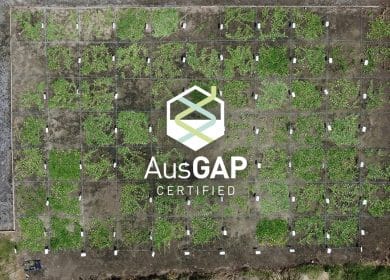Winter desiccation and the effects on spring green-up

Australia mostly specialises in warm season turfgrass varieties for their environmental benefits, however how do they hold up to Australian winters? Winter desiccation or winter kill off is the permanent and lethal dehydration of plant material and as leaf tissue dies, survival of the turfgrass is shifted to the crown. The survival of a turfgrass crown, or growing point of the plant, is essential for winter survival as its viability will ensure rapid recovery in the spring. Recovering from winter killoff or desiccation is dependent on the actions taken during that winter to prevent or minimize harm to the turf and allow for fast recovery for spring green-up. Read on to find out about winter killoff and what studies suggest to be the best preventative methods to allow for faster spring green-up.
Winter killoff or desiccation is often unpredictable when trying to recover from it, as it occurs in sporadic and erratic ways. Often, the degree of winterkill is not fully understood until turf growth resumes in spring (Michael et al., 2016). Timely re-establishment of turf is critical in sports turf settings to minimise facility downtime, time with poor playing conditions, and prevent encroachment from off types and weeds.
What happens to turf during winter killoff?
Turf during winter can experience winterkill off due to lack of plant available water. Transpiration tends to exceed plant water uptake during extended periods of time inducing lethal dehydration. This lethal drying of plant material can be caused by inaccessible frozen soil-water or lack of soil-water. When winterkill off occurs a process called plasmolysis occurs (Vicrè et al., 2004), in which the membrane contracts from the cell wall, causing the cell walls to fold and collapse. During this process all cellular function can be lost, and cell death will occur (Stier and Fei et al., 2008).
What are studies saying about preventative methods?
There are several methods used in order to minimise winter desiccation and killoff that can range from applying products, turf covers, and even sand topdressing.
Studies are suggesting that covers on putting greens increase soil and leaf moisture content (Roberts et al., 1986). However, the use of protective covers is usually limited to putting greens because they are labour-intensive to employ, and generally not cost effective for large areas.
Sand topdressing is also said to be an effective preventative method. For example, the sand buries the crown and sustains the crowns moisture improving turf survival. Therefore, reducing the likelihood of turf death from winter desiccation (Michael et al., 2016).
There are several products marketed to the industry as tools for reducing desiccation. These products include anti-transpirants, horticultural spray oil with green pigment, turf colorants containing green pigments, and soil wetting agents. Sustaining uniform soil moisture in desiccating environments could reduce desiccation pressure (Cavanaugh et al., 2015). While some evidence suggests many of these products have potential in reducing desiccation, no results have been published to validate their role in desiccation prevention of turfgrass.
How do these methods effect spring green-up?
Timely spring green-up is critical to most sports turf facilities as to ensure plant health is optimal as well as wear tolerance. For example, studies have found a correlation between the effectiveness of the above preventative methods and spring green-up timing and quality (Michael et al., 2016). Of these methods, turf covers, and sand topdressing seemed to be the most effective at retaining crown moisture. Furthermore, studies suggest that treatments that sustained crown moisture content levels throughout the winter result in a higher turf quality in the spring and faster recovery.
As winter turf practices evolve it is important to evaluate the effects they have on re-establishment in the spring. Traditional practices have proven to maintain crown hydration essential to turfgrass health while transitioning through the seasons. In conclusion, more study needs to be done to further evaluate the effectiveness of chemical products on winterkill off and desiccation to help reduce labour intensive methods such as turf covers and sand topdressing.
References:
Bauer, S. J., Cavanaugh, M. J., & Horgan, B. P. (2017). Wetting agent influence on putting green surface firmness. Itsrj, 13(1), 624. https://doi.org/10.2134/itsrj2016.06.0490
Roberts, J. M. (1986). Influence of protective covers on reducing winter desiccation of turf. Agronomy Journal, 78(1), 145–147. https://doi.org/10.2134/agronj1986.00021962007800010029x
Stier, J.C. & Fei, S.-Z. (2007). Cold-stress physiology and management of turfgrasses. https://doi.org/10.1201/9781420006483
Vicrè, M., J. Farrant, and A. Driouich. (2004). Insights into the cellular mechanisms of desiccation tolerance among angiosperm resurrection plant species. Plant, Cell & Environment, 27(11), 1329–1340. https://doi.org/10.1111/j.1365-3040.2004.01212.x
Michael, D. (2016) Winter desiccation prevention and recovery in turfgrass. https://digitalcommons.unl.edu/cgi/viewcontent.cgi?article=1120&context=agronhortdiss


